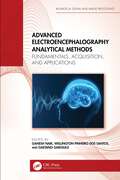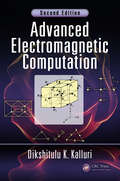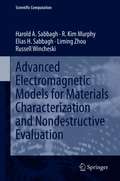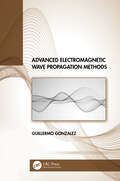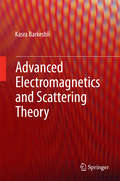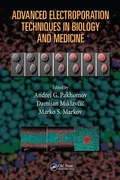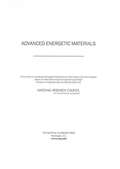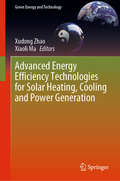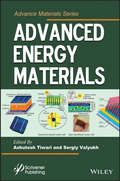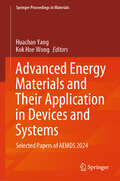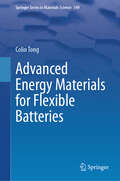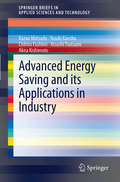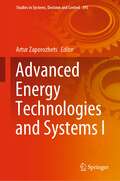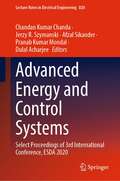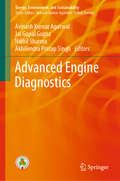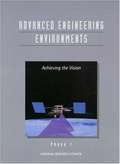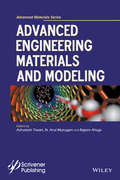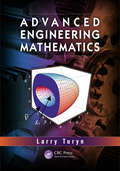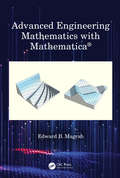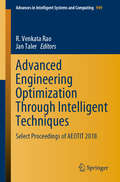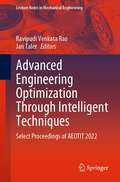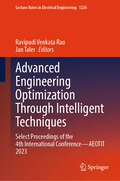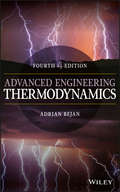- Table View
- List View
Advanced Electroencephalography Analytical Methods: Fundamentals, Acquisition, and Applications (Biomedical Signal and Image Processing)
by Ganesh Naik Santos, Wellington Pinheiro dos Gaetano GargiuloAdvanced Electroencephalography Analytical Methods: Fundamentals, Acquisition, and Applications presents the theoretical basis and applications of electroencephalography (EEG) signals in neuroscience, involving signal analysis, processing, signal acquisition, representation, and applications of EEG signal analysis using non-linear approaches and machine learning. It explains principles of neurophysiology, linear signal processing, computational intelligence, and the nature of signals including machine learning. Applications involve computer-aided diagnosis, brain-computer interfaces, rehabilitation engineering, and applied neuroscience.This book: Includes a comprehensive review on biomedical signals nature and acquisition aspects. Focuses on selected applications of neuroscience/cardiovascular/muscle-related biomedical areas. Provides a machine learning update to a classical biomedical signal processing approach. Explains deep learning and application to biomedical signal processing and analysis. Explores relevant biomedical engineering and neuroscience state-of-the-art applications. This book is intended for researchers and graduate students in biomedical signal processing, electrical engineering, neuroscience, and computer science.
Advanced Electromagnetic Computation
by Dikshitulu K. KalluriAdvanced Electromagnetic Computation with MATLAB® discusses commercial electromagnetic software, widely used in the industry. Algorithms of Finite Differences, Moment method, Finite Element method and Finite Difference Time Domain method are illustrated. Hand-computed simple examples and MATLAB-coded examples are used to explain the concepts behind the algorithms. Case studies of practical examples from transmission lines, waveguides, and electrostatic problems are given so students are able to develop the code and solve the problems. Two new chapters including advanced methods based on perturbation techniques and three dimensional finite element examples from radiation scattering are included.
Advanced Electromagnetic Models for Materials Characterization and Nondestructive Evaluation (Scientific Computation)
by Elias H. Sabbagh Harold A Sabbagh R. Kim Murphy Liming Zhou Russell WincheskiThis book expands on the subject matter of ’Computational Electromagnetics and Model-Based Inversion: A Modern Paradigm for Eddy-Current Nondestructive Evaluation.’ It includes (a) voxel-based inversion methods, which are generalizations of model-based algorithms; (b) a complete electromagnetic model of advanced composites (and other novel exotic materials), stressing the highly anisotropic nature of these materials, as well as giving a number of applications to nondestructive evaluation; and (c) an up-to-date discussion of stochastic integral equations and propagation-of-uncertainty models in nondestructive evaluation. As such, the book combines research started twenty-five years ago in advanced composites and voxel-based algorithms, but published in scattered journal articles, as well as recent research in stochastic integral equations. All of these areas are of considerable interest to the aerospace, nuclear power, civil infrastructure, materials characterization and biomedical industries. The book covers the topic of computational electromagnetics in eddy-current nondestructive evaluation (NDE) by emphasizing three distinct topics: (a) fundamental mathematical principles of volume-integral equations as a subset of computational electromagnetics, (b) mathematical algorithms applied to signal-processing and inverse scattering problems, and (c) applications of these two topics to problems in which real and model data are used. It is therefore more than an academic exercise and is valuable to users of eddy-current NDE technology in industries as varied as nuclear power, aerospace, materials characterization and biomedical imaging.
Advanced Electromagnetic Wave Propagation Methods
by Guillermo GonzalezThis textbook provides a solid foundation into many approaches that are used in the analysis of advanced electromagnetic wave propagation problems. The techniques discussed are essential to obtain closed-form solutions or asymptotic solutions and meet an existing need for instructors and students in electromagnetic theory. The book covers various advanced mathematical methods used in the evaluation of the electromagnetic fields in rectangular, cylindrical and spherical geometries. The mathematics of special functions (i.e., Bessel, Hankel, Airy, Legendre, Error, etc.) are covered in depth, including appropriate Appendices. The author takes particular care to provide detailed explanations of auxiliary potentials, Hertz’s vectors, Debye potentials, as well as the use of Green functions, the Watson transformation and the method of steepest descent in the solution of electromagnetic problems. Overall, Advanced Electromagnetic Wave Propagation Methods is a good source for the many skills required in obtaining closed form and asymptotic solution, which in many instances cannot be obtained using computer codes of Maxwell’s equations. Thus, it provides an excellent training for preparing graduate students in their research work. This book is intended for a graduate course in electromagnetic theory for students in electrical engineering. Students in physics and professionals will also find it appropriate and useful. Provides a comprehensive and unified treatment of radiation and propagation problems Presents a detailed explanation in the use of Green functions, the Watson transformation and the method of steepest descent as they apply to electromagnetic problems Demonstrates various advanced mathematical techniques used in the evaluation of the electromagnetic fields Details how to formulate and obtain a closed-form solution or an asymptotic solution Includes appendices for Bessel, Legendre, Airy and Error functions
Advanced Electromagnetics and Scattering Theory
by Kasra Barkeshlisina KhorasaniThis book present the lecture notes used in two courses that the late Professor Kasra Barkeshli had offered at Sharif University of Technology, namely, Advanced Electromagnetics and Scattering Theory. The prerequisite for the sequence is vector calculus and electromagnetic fields and waves. Some familiarity with Green's functions and integral equations is desirable but not necessary. The book provides a brief but concise introduction to classical topics in the field. It is divided into three parts including annexes. Part I covers principle of electromagnetic theory. The discussion starts with a review of the Maxwell's equations in differential and integral forms and basic boundary conditions. The solution of inhomogeneous wave equation and various field representations including Lorentz's potential functions and the Green's function method are discussed next. The solution of Helmholtz equation and wave harmonics follow. Next, the book presents plane wave propagation in dielectric and lossy media and various wave velocities. This part concludes with a general discussion of planar and circular waveguides. Part II presents basic concepts of electromagnetic scattering theory. After a brief discussion of radar equation and scattering cross section, the author reviews the canonical problems in scattering. These include the cylinder, the wedge and the sphere. The edge condition for the electromagnetic fields in the vicinity of geometric discontinuities are discussed. The author also presents the low frequency Rayleigh and Born approximations. The integral equation method for the formulation of scattering problems is presented next, followed by an introduction to scattering from periodic structures. Part III is devoted to numerical methods. It begins with finite-difference methods to solve elliptic equations, and introduces the finite-difference time-domain method for the solution of hyperbolic and parabolic equations. Next, the part turns to the method of moments for the solution of integral equations. This part ends with a short introduction to the finite-element method.
Advanced Electroporation Techniques in Biology and Medicine (Biological Effects of Electromagnetics)
by Marko S. Markov Andrei G. Pakhomov Damijan MiklavcicA reflection of the intense study of the effects of electromagnetic fields on living tissues that has taken place during the last decades, Advanced Electroporation Techniques in Biology and Medicine summarizes most recent experimental findings and theories related to permeabilization of biomembranes by pulsed electric fields. Edited by experts and
Advanced Energetic Materials
by Committee on Advanced Energetic Materials Manufacturing TechnologiesAdvanced energetic materials—explosive fill and propellants—are a critical technology for national security. While several new promising concepts and formulations have emerged in recent years, the Department of Defense is concerned about the nation’s ability to maintain and improve the knowledge base in this area. To assist in addressing these concerns, two offices within DOD asked the NRC to investigate and assess the scope and health of the U.S. R&D efforts in energetic materials. This report provides that assessment. It presents several findings about the current R&D effort and recommendations aimed at improving U.S. capabilities in developing new energetic materials technology. This study reviewed U.S. research and development in advanced energetics being conducted by DoD, the DoE national laboratories, industries, and academia, from a list provided by the sponsors. It also: (a) reviewed papers and technology assessments of non-U.S. work in advanced energetics, assessed important parameters, such as validity, viability, and the likelihood that each of these materials can be produced in quantity; (b) identified barriers to scale-up and production, and suggested technical approaches for addressing potential problems; and (c) suggested specific opportunities, strategies, and priorities for government sponsorship of technologies and manufacturing process development.
Advanced Energy Efficiency Technologies for Solar Heating, Cooling and Power Generation (Green Energy and Technology)
by Xudong Zhao Xiaoli MaThis book, based on the research experience and outcomes of a group of international contributors, addresses a range of advanced energy efficiency technologies and their applications in solar heating, cooling and power generation, while also providing solutions for tackling recurring low efficiency problems in today’s systems. It highlights the latest technologies and methods, which can significantly improve the performance of solar systems, enabling readers to design, construct and apply high-performance solar systems in or for their own projects. The contributors provide a systematic introduction to state-of-the-art energy efficiency technologies that demonstrates how to implement innovative solar systems. These technologies include: • heat pipes and loop heat pipes; • phase change materials (PCMs) and PCM slurries; • micro-channel panels; • desiccant/adsorption cycling; • ejector cooling and heat pumps; and • solar concentration and thermoelectric units. The book shows how innovative solar systems applicable to rural and urban buildings can be analysed and demonstrates the successful implementation of these advanced technologies. It delivers the design principles and associated energy performance assessment methods for a range of selected solar heating, cooling and power generation projects. This book offers a valuable source of information for final-year undergraduate students, as well as graduate students and academic lecturers, as it promotes the widespread deployment of advanced solar heating, cooling and power generation technologies applicable for buildings across the globe. The book is also a good point of reference for design engineers and energy consultants who wish to extend their knowledge of advanced technologies used to achieve energy efficiency.
Advanced Energy Materials
by Ashutosh Tiwari Sergiy ValyukhAn essential resource for scientists designing new energy materials for the vast landscape of solar energy conversion as well as materials processing and characterizationBased on the new and fundamental research on novel energy materials with tailor-made photonic properties, the role of materials engineering has been to provide much needed support in the development of photovoltaic devices. Advanced Energy Materials offers a unique, state-of-the-art look at the new world of novel energy materials science, shedding light on the subject's vast multi-disciplinary approachThe book focuses particularly on photovoltaics, efficient light sources, fuel cells, energy-saving technologies, energy storage technologies, nanostructured materials as well as innovating materials and techniques for future nanoscale electronics. Pathways to future development are also discussed.Critical, cutting-edge subjects are addressed, including:Non-imaging focusing heliostat; state-of-the-art of nanostructuresMetal oxide semiconductors and their nanocompositesSuperionic solids; polymer nanocomposites; solid electrolytes; advanced electronicsElectronic and optical properties of lead sulfideHigh-electron mobility transistors and light-emitting diodesAnti-ferroelectric liquid crystals; PEEK membrane for fuel cellsAdvanced phosphors for energy-efficient lightingMolecular computation photovoltaics and photocatalystsPhotovoltaic device technology and non-conventional energy applicationsReadershipThe book is written for a large and broad readership including researchers and university graduate students from diverse backgrounds such as chemistry, materials science, physics, and engineering working in the fields of nanotechnology, photovoltaic device technology, and non-conventional energy.
Advanced Energy Materials and Their Application in Devices and Systems: Selected Papers of AEMDS 2024 (Springer Proceedings in Materials #62)
by Huachao Yang Kok Hoe WongThis book provides insights into cutting-edge developments in energy materials, devices, and systems, as presented at the International Conference on Advanced Energy Materials, Devices, and Systems (AEMDS 2024) in Ningbo, China, from June 28 to 29, 2024. Focusing on the global demand for high-performance energy storage devices, the conference explores advancements in materials crucial for their development. AEMDS 2024 serves as a platform for discussions on experimental breakthroughs, ongoing developments, and practical applications in the field. Keynote and invited speakers from the global energy domain contribute to a dynamic exchange of ideas, promoting a deeper understanding of emerging energy materials and their applications across various research fields.
Advanced Energy Materials for Flexible Batteries (Springer Series in Materials Science #349)
by Colin TongThis book provides a comprehensive guide to the cutting-edge science and engineering behind the development of flexible batteries. These innovative devices, capable of bending, twisting, and stretching, hold immense potential for applications ranging from wearable electronics to large-scale energy storage systems. The book presents a thorough overview of the essential materials and design principles that underpin flexible battery technology. It explores the latest advancements in electrode materials, electrolytes, and separators, focusing on materials that exhibit exceptional flexibility, high energy density, and excellent rate capability. In addition to materials selection, the book addresses the challenges and opportunities associated with designing and manufacturing flexible batteries. It discusses strategies for creating flexible battery cells that can withstand mechanical deformation, as well as efficient manufacturing processes and performance evaluation methods. By offering a deep understanding of the materials science and engineering principles governing flexible batteries, this book aims to inspire further research and development in this rapidly evolving field. This book is an essential resource for engineers and materials scientists involved in battery development.
Advanced Energy Saving and its Applications in Industry (SpringerBriefs in Applied Sciences and Technology)
by Atsushi Tsutsumi Akira Kishimoto Chihiro Fushimi Yasuki Kansha Kazuo MatsudaThe conventional approach for energy saving in a process system is to maximize heat recovery without changing any process conditions by using pinch technology. "Self-heat recuperation technology" was developed to achieve further energy saving in the process system by eliminating the necessity for any external heat input, such as firing or imported steam. Advanced Energy Saving and its Applications in Industry introduces the concept of self-heat recuperation and the application of such technology to a wide range of processes from heavy chemical complexes to other processes such as drying and gas separation processes, which require heating and cooling during operation. Conventional energy saving items in a utility system are applied and implemented based on a single site approach, however, when looking at heavy chemical complexes, it was apparent that the low-grade heat discharged as waste from a refinery could also be used in an adjacent petrochemical plant. There could therefore be a large energy saving potential by utilizing the surplus heat across the sites. Advanced Energy Saving and its Applications in Industry assesses conventional approaches to industrial energy saving and explains and outlines new methods to provide even greater energy saving potential. Advanced Energy Saving and its Applications in Industry provides a key resource and research tool for all those involved in developing the energy efficiency of industrial processes. Researchers, industry professionals and even students with an interest in green engineering will find the summaries of the conventional and suggested new methods useful when attempting to advance further development within this field.
Advanced Energy Technologies and Systems I (Studies in Systems, Decision and Control #395)
by Artur ZaporozhetsThis book focuses on modern technologies and systems for solving problems in the energy sector. It is shown that bioenergy is one of the promising areas of energy development. The book collected the experience of scientists from many countries in the research of renewable energy. The advantages of renewable energy are general availability, renewability, environmental friendliness. The analysis carried out by the authors shows the current state of renewable energy in the world, its trends and prospects. New measuring systems are presented, which can become the basis for measuring the thermal characteristics of various types of fuels, including biofuels, insulating materials, enclosing structures, etc. System for monitoring of grainy biomass comminution with the use of genetic algorithms has been presented and described. New technologies for the construction of power plants based on renewable energy sources have been proposed and investigated.
Advanced Energy and Control Systems: Select Proceedings of 3rd International Conference, ESDA 2020 (Lecture Notes in Electrical Engineering #820)
by Afzal Sikander Dulal Acharjee Chandan Kumar Chanda Pranab Kumar Mondal Jerzy R. SzymanskiThis book gathers selected research papers presented at the Third International Conference on Energy Systems, Drives, and Automations (ESDA 2020). It covers a broad range of topics in the fields of renewable energy, power management, drive systems for electrical machines, and automation. In a spam of about a few interesting articles, effort had gone in to critically discuss about the control system, energy management and distribution in a unified approach common to electrical, Control and mechanical engineering. This book also comprehensively discusses a variety of related tools and techniques and will be a valuable resource for researchers, professionals, and students in electrical and mechanical engineering disciplines.
Advanced Engine Diagnostics (Energy, Environment, and Sustainability)
by Avinash Kumar Agarwal Akhilendra Pratap Singh Jai Gopal Gupta Nikhil SharmaThis book describes the discusses advanced fuels and combustion, emission control techniques, after-treatment systems, simulations and fault diagnostics, including discussions on different engine diagnostic techniques such as particle image velocimetry (PIV), phase Doppler interferometry (PDI), laser ignition. This volume bridges the gap between basic concepts and advanced research in internal combustion engine diagnostics, making it a useful reference for both students and researchers whose work focuses on achieving higher fuel efficiency and lowering emissions.
Advanced Engineering Dynamics
by Jerry H. GinsbergThis text offers a clear and refreshing exposition of the dynamics of mechanical systems from an engineering perspective. The author thoroughly covers basic concepts and applies them in a systematic manner to solve problems in mechanical systems with applications to engineering. Numerous illustrative examples accompany all theoretical discussions, and each chapter offers a wealth of homework problems. The treatment of the kinematics of particles and rigid bodies is extensive. In this new edition the author has revised and reorganized sections to enhance understanding of physical principles, and he has modified and added examples, as well as homework problems. The new edition also contains a thorough development of computational methods for solving the differential equations of motion for constrained systems. Seniors and graduate students in engineering will find this book to be extremely useful. Solutions manual available.
Advanced Engineering Environments: Achieving the Vision
by National Research CouncilReport on Advanced Engineering Environments.
Advanced Engineering Materials and Modeling
by Ashutosh Tiwari N. Arul Murugan Rajeev AhujaThe engineering of materials with advanced features is driving the research towards the design of innovative materials with high performances. New materials often deliver the best solution for structural applications, precisely contributing towards the finest combination of mechanical properties and low weight. The mimicking of nature's principles lead to a new class of structural materials including biomimetic composites, natural hierarchical materials and smart materials. Meanwhile, computational modeling approaches are the valuable tools complementary to experimental techniques and provide significant information at the microscopic level and explain the properties of materials and their very existence. The modeling also provides useful insights to possible strategies to design and fabricate materials with novel and improved properties. The book brings together these two fascinating areas and offers a comprehensive view of cutting-edge research on materials interfaces and technologies the engineering materials. The topics covered in this book are divided into 2 parts" Engineering of Materials, Characterizations & Applications and Computational Modeling of Materials. The chapters include the following: Mechanical and resistance behavior of structural glass beams Nanocrystalline metal carbides - microstructure characterization SMA-reinforced laminated glass panel Sustainable sugarcane bagasse cellulose for papermaking Electrospun scaffolds for cardiac tissue engineering Bio-inspired composites Density functional theory for studying extended systems First principles based approaches for modeling materials Computer aided materials design Computational materials for stochastic electromagnets Computational methods for thermal analysis of heterogeneous materials Modelling of resistive bilayer structures Modeling tunneling of superluminal photons through Brain Microtubules Computer aided surgical workflow modeling Displaced multiwavelets and splitting algorithms
Advanced Engineering Mathematics
by Lawrence TurynBeginning with linear algebra and later expanding into calculus of variations, Advanced Engineering Mathematics provides accessible and comprehensive mathematical preparation for advanced undergraduate and beginning graduate students taking engineering courses. This book offers a review of standard mathematics coursework while effectively integrati
Advanced Engineering Mathematics with Mathematica
by Edward B. MagrabAdvanced Engineering Mathematics with Mathematica® presents advanced analytical solution methods that are used to solve boundary-value problems in engineering and integrates these methods with Mathematica® procedures. It emphasizes the Sturm–Liouville system and the generation and application of orthogonal functions, which are used by the separation of variables method to solve partial differential equations. It introduces the relevant aspects of complex variables, matrices and determinants, Fourier series and transforms, solution techniques for ordinary differential equations, the Laplace transform, and procedures to make ordinary and partial differential equations used in engineering non-dimensional. To show the diverse applications of the material, numerous and widely varied solved boundary value problems are presented.
Advanced Engineering Mathematics with Modeling Applications
by S. Graham KellyA graduate level text, this book presents a unique combination of theoretical mathematics and engineering applications. It demonstrates the relationship between advanced mathematics and engineering principles, introduces engineering mathematics at a theoretical level, and includes functional analysis topics such as vector spaces, inner products, and norms and develops advanced mathematical methods from this foundation. The author does not focus on proving theorems but on the application of the theorems to the solution of engineering problems. In sum, the book provides an overview of the principles and techniques of advanced mathematics as applied to mechanical engineering problems.
Advanced Engineering Optimization Through Intelligent Techniques: Select Proceedings of AEOTIT 2018 (Advances in Intelligent Systems and Computing #949)
by R. Venkata Rao Jan TalerThis book comprises select peer-reviewed papers presented at the International Conference on Advanced Engineering Optimization Through Intelligent Techniques (AEOTIT) 2018. The book combines contributions from academics and industry professionals, and covers advanced optimization techniques across all major engineering disciplines like mechanical, manufacturing, civil, automobile, electrical, chemical, computer and electronics engineering. Different optimization techniques and algorithms such as genetic algorithm (GA), differential evolution (DE), simulated annealing (SA), particle swarm optimization (PSO), artificial bee colony (ABC) algorithm, artificial immune algorithm (AIA), teaching-learning-based optimization (TLBO) algorithm and many other latest meta-heuristic techniques and their applications are discussed. This book will serve as a valuable reference for students, researchers and practitioners and help them in solving a wide range of optimization problems.
Advanced Engineering Optimization Through Intelligent Techniques: Select Proceedings of AEOTIT 2022 (Lecture Notes in Mechanical Engineering)
by Ravipudi Venkata Rao Jan TalerThis book comprises peer-reviewed papers presented at the International Conference on Advanced Engineering Optimization Through Intelligent Techniques (AEOTIT) 2022. The book combines contributions from academics and industry professionals and covers advanced optimization techniques across all major engineering disciplines like mechanical, manufacturing, civil, automobile, electrical, chemical, computer, and electronics engineering. The book discusses different optimization techniques and algorithms such as genetic algorithm, non-dominated sorting genetic algorithm-II, and III, differential search, particle swarm optimization, fruit fly algorithm, cuckoo search, teaching–learning-based optimization algorithm, grey wolf optimization, Jaya algorithm, Rao algorithms, and many other latest meta-heuristic techniques and their applications. Various multi-attribute decision-making methods such as AHP, TOPSIS, ELECTRE, PROMETHEE, DEMATEL, R-method, fuzzy logic, and their applications are also discussed. This book serves as a valuable reference for students, researchers, and practitioners and helps them in solving a wide range of optimization problems.
Advanced Engineering Optimization Through Intelligent Techniques: Select Proceedings of the 4th International Conference—AEOTIT 2023 (Lecture Notes in Electrical Engineering #1226)
by Ravipudi Venkata Rao Jan TalerThis book comprises peer-reviewed papers presented at the 4th International Conference on Advanced Engineering Optimization Through Intelligent Techniques (AEOTIT) 2023. The book combines contributions from academics and industry professionals and covers advanced optimization techniques across all major engineering disciplines like mechanical, manufacturing, civil, electrical, chemical, computer, and electronics engineering. The book discusses different optimization techniques and algorithms such as genetic algorithm, non-dominated sorting genetic algorithm-II, and III, particle swarm optimization, gravitational search algorithm, ant lion optimization, dragonfly algorithm, teaching–learning-based optimization algorithm, grey wolf optimization, Jaya algorithm, Rao algorithms, many other latest meta-heuristic techniques, machine learning algorithms, and their applications. Various multi-attribute decision-making methods such as AHP, TOPSIS, PROMETHEE, desirability function, SWARA, R-method, BHARAT method, Taguchi method, fuzzy logic, and their applications are also discussed. This book serves as a valuable reference for students, researchers, and practitioners and helps them in solving a wide range of optimization problems.
Advanced Engineering Thermodynamics
by Adrian BejanAn advanced, practical approach to the first and second laws of thermodynamics Advanced Engineering Thermodynamics bridges the gap between engineering applications and the first and second laws of thermodynamics. Going beyond the basic coverage offered by most textbooks, this authoritative treatment delves into the advanced topics of energy and work as they relate to various engineering fields. This practical approach describes real-world applications of thermodynamics concepts, including solar energy, refrigeration, air conditioning, thermofluid design, chemical design, constructal design, and more. This new fourth edition has been updated and expanded to include current developments in energy storage, distributed energy systems, entropy minimization, and industrial applications, linking new technologies in sustainability to fundamental thermodynamics concepts. Worked problems have been added to help students follow the thought processes behind various applications, and additional homework problems give them the opportunity to gauge their knowledge. The growing demand for sustainability and energy efficiency has shined a spotlight on the real-world applications of thermodynamics. This book helps future engineers make the fundamental connections, and develop a clear understanding of this complex subject. Delve deeper into the engineering applications of thermodynamics Work problems directly applicable to engineering fields Integrate thermodynamics concepts into sustainability design and policy Understand the thermodynamics of emerging energy technologies Condensed introductory chapters allow students to quickly review the fundamentals before diving right into practical applications. Designed expressly for engineering students, this book offers a clear, targeted treatment of thermodynamics topics with detailed discussion and authoritative guidance toward even the most complex concepts. Advanced Engineering Thermodynamics is the definitive modern treatment of energy and work for today's newest engineers.
